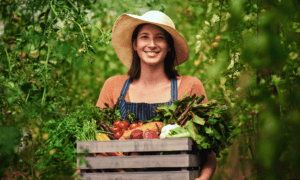Food and beverage companies face new and familiar risks as the industry evolves in an ever-changing global economy. Leading trends shaping the industry today include ongoing inflation, an increased push toward sustainability, regenerative agriculture, carbon labeling, food safety, and more.
Managing Inflation Risks and Costs
Although inflation has moderated for many consumer categories in the United States, consumers’ sentiments are that food prices remain high. Grocery prices are maintaining levels above the inflation rates due to a mixture of labor shortages tied to the pandemic, continued supply chain disruptions, droughts, avian flu, and other factors.
There are indicators that inflation is slowing as certain commodity prices are beginning to decrease and forecasting models suggest food prices will have only increased 2.9% for 2024 (marking the smallest percentage increase of the last seven years). Despite this significant decrease from recent inflation levels, consumer sentiments are that food prices remain too high, primarily resulting from the impact of recent years’ elevated inflation results.
Even as price increases moderate and food prices stabilize or even decline, food producers and retailers are facing market risks and pressure to reduce costs. It will likely take a significant time for consumers to adjust from the current perception that everything costs more. In the meantime, well-positioned companies are using price positioning to increase volume and take market share.
Non-GMO and Lab-Based Foods
Consumers are starting to worry even more about how traditional food production methods are harming the environment. As a potential solution, industry professionals have gained interest in the use of “cultivated meat.” The cultivation process produces meat created in large-scale lab operations that are marketed as a more sustainable option.
Advocates present cultivated meat as an environmentally friendly alternative to conventionally farmed meat and boast about the carbon-cutting advantages of lab-grown meat. But despite the potential advantages of relying less on traditional farming and ranching methods for meat, many challenges remain before production and consumer acceptance become common.
For example, genetically modified organisms (“GMOs”) have been a controversial fixture in the food and beverage industry for decades, and consumer acceptance of these products remains mixed. At present, cultivated meat products are costly and scaling the industry will be critical to making these products affordable for consumers. Scaling comes with its own challenges, as the scope of manufacturing required to reach economies of scale requires significant capital, time, and labor supply to be met.
Lab-grown food will also likely face regulatory hurdles. The U.S. Food and Drug Administration, Environmental Protection Agency, and Department of Agriculture all have responsibility for food safety, including foods that are GMOs or have GMO ingredients. Inevitably, lobbying interests will impact the pace in which new products will be able to come to market and with what regulation they are likely to face.
Regenerative Agriculture
Regenerative agriculture—farming and ranching in harmony with nature to restore soil and ecosystem health, address inequity, and leave land, waters, and climate in better shape for future generations—is gaining momentum among food producers.
The practices of regenerative agriculture—many of which have been utilized by Indigenous communities for centuries—include techniques such as:
- Cover cropping
- Rotational grazing
- No-till farming
- Composting
- Reduced fossil fuel-based inputs
- Agroforestry
- And other methods
Regenerative agriculture offers ecological, economic, and social benefits.
The broader idea involves prioritizing soil health, reducing synthetic inputs, and giving back to the community. Conversely, more intrusive agricultural methods emphasize short-term crop output with less regard for the effects on the larger ecosystem.
Long-term resilience balanced with short-term profitability are essential components of the equation when it comes to adopting more regenerative approaches; regenerative farms must be able to maintain profitability in the short run for changes to techniques to be attractive.
Current U.S. farm policy does not promote or encourage regenerative practices, though some states, including California, have implemented incentive programs. Story-telling and the willingness to share the successes (and failures) of early adopters will be critical to achieving increases in consumer demand and mitigation of producer risk while adopting new processes on the farm.
Carbon Labeling
Much like how nutrition labels quantify the ingredients and energy composition of products, a carbon label empowers consumers to make more sustainable choices by providing data on how a product’s production, manufacturing, and packaging negatively impacts the environment (or positively impacts the environment as the case may be for certain regenerative products).
Every product’s carbon footprint can be calculated. While the specific methodology for calculating per-product emissions varies, the objective is to quantify the environmental impact of consumption through consideration of a product’s entire carbon lifecycle: emissions from the start of being grown, during transportation, and through recycling of packaging.
The type of label can vary by product, but studies have shown simplicity is a key consideration when it comes to effectiveness for consumers at this time. As more companies adopt reporting and customer education on this topic increases, best practices are expected to emerge. As with any product claim, companies should be prepared to substantiate their claims. Greenhouse gas (GHG) calculations or life cycle analyses conducted by independent third parties are highly recommended, as is obtaining assurance for GHG calculations.
Policies for carbon labeling are starting to emerge in the European Union, and some U.S.-based companies are starting to provide this information to consumers.
Food Safety
In response to enhanced regulation, food processors are leveraging technology to provide enhanced visibility into the supply chain, as well as traceability and transparency so consumers can know more about the food they’re consuming.
The Interagency Food Safety Analytics Collaboration was formed by the Centers for Disease Control and Prevention (“CDC”), Food and Drug Administration (“FDA”), and Food Safety and Inspection Services (“FSIS”) to help improve the country’s understanding of foodborne diseases. The group will focus its efforts on reducing illness from four pathogens commonly cited in foodborne diseases (Salmonella, E. coli O157:H7, Listeria Monocytogenes, and Campylobacter).
The group recently published its 2024-2028 strategic priorities, focusing on more clearly identifying the sources of illness outbreaks, improving data quality to reduce potential exposures, and enhancing food safety.
Mental Health and Diet
Research continues to demonstrate the positive relationship between nutrition and mental health, suggesting an opportunity to enhance therapeutic and pharmacological treatments with dietary intervention.
Evidence-based guidelines can be based on clinical research and “prescribed” by medical professionals, but there are gaps in the guidance when it comes to labeling foods as being “good” for mental health.
The FDA oversees health claims, which are defined as statements linking a food to a reduced risk of disease or a health-related condition. These claims are more commonly associated with physical ailments, such as heart disease. However, structure/function claims—describing how a food or ingredient affects a function of the body—do not require FDA authorization.
To learn more about how we can help your food or beverage business with any or all of the above topics, contact us.
















